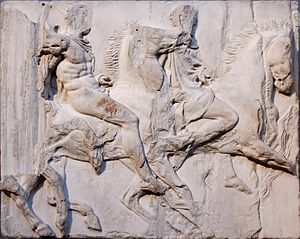
Back النحت في اليونان القديمة Arabic Древногръцка скулптура Bulgarian Escultura grega Catalan Αρχαία ελληνική γλυπτική Greek Escultura de la Antigua Grecia Spanish Antzinako Greziako eskultura Basque Antiikin Kreikan kuvanveisto Finnish Sculpture grecque antique French Escultura da Grecia antiga Galician פיסול יווני HE

The sculpture of ancient Greece is the main surviving type of fine ancient Greek art as, with the exception of painted ancient Greek pottery, almost no ancient Greek painting survives. Modern scholarship identifies three major stages in monumental sculpture in bronze and stone: the Archaic (from about 650 to 480 BC), Classical (480–323 BC) and Hellenistic. At all periods there were great numbers of Greek terracotta figurines and small sculptures in metal and other materials.

The Greeks decided very early on that the human form was the most important subject for artistic endeavour.[1] Seeing their gods as having human form, there was little distinction between the sacred and the secular in art—the human body was both secular and sacred. A male nude of Apollo or Heracles had only slight differences in treatment to one of that year's Olympic boxing champion. The statue, originally single but by the Hellenistic period often in groups was the dominant form, though reliefs, often so "high" that they were almost free-standing, were also important.
- ^ Cook, 19